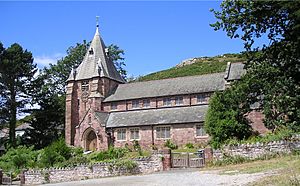All Saints Church, Deganwy facts for kids
Quick facts for kids All Saints Church, Deganwy |
|
|---|---|

All Saints Church, Deganwy, from the south
|
|
| 53°17′39″N 3°49′37″W / 53.2941°N 3.8270°W | |
| Location | Deganwy, Conwy County Borough |
| Country | Wales |
| Denomination | Church in Wales |
| Website | All Saints, Deganwy |
| History | |
| Founder(s) | Lady Augusta Mostyn |
| Dedication | All Saints |
| Architecture | |
| Functional status | Active |
| Heritage designation | Grade II* |
| Designated | 24 June 1986 |
| Architect(s) | John Douglas |
| Architectural type | Church |
| Style | Gothic Revival |
| Groundbreaking | 1897 |
| Completed | 1899 |
| Administration | |
| Parish | Eglwysrhos (or Llanrhos) |
| Deanery | Llanrwst |
| Archdeaconry | St Asaph |
| Diocese | St Asaph |
| Province | Wales |
All Saints Church, Deganwy is a beautiful church located in the town of Deganwy, Wales. It sits on a hill, offering amazing views over the Conwy estuary. This church is part of the Church in Wales, which is a Christian church in Wales.
About All Saints Church
All Saints Church is still an active church today. It belongs to a group of churches called the benefice of Eglwysrhos (or Llanrhos). It is also part of the larger diocese of St Asaph.
Why Is It Special?
This church is very important because it is a Grade II* listed building. This means it's a special building that is protected because of its history and amazing architecture. Cadw, a Welsh government group, decided it was important enough to be listed.
The church was built a long time ago, between 1897 and 1899. It was created as a special "memorial church" by Lady Augusta Mostyn. A memorial church is built to remember someone or something important. The famous architect John Douglas from Chester designed it. He made sure it had a great view of the Conwy estuary.
The church has some interesting parts to its design. It has a clerestory, which is a high section of wall with windows above the main roof. The chancel, where the altar is, is higher than the nave, which is the main part of the church where people sit. It also has a tall tower at the west end. The style of the church is called Gothic Revival, which means it looks like older medieval churches.
The Church Organ
Inside All Saints Church, there is a large pipe organ. This organ has two keyboards, called manuals. It was built in 1899 by a company called Alex Young and Sons from Manchester. Later, in 1972, it was updated by L. Reeves to keep it working well.
More to Explore

